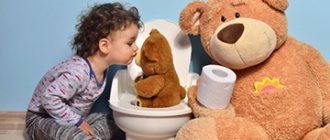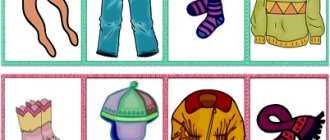At a certain stage of growing up, a child comes to a point when he must say goodbye to the usual potty and learn to use an adult toilet.
There is no standard at what age a child should already go to the toilet like an adult. Everything is individual, but usually the process of transition from potty to toilet is completed by 4-5 years.
Toilet training, like potty training, is not accepted easily and painlessly by all children. Some children may even resist these innovations in every possible way.
Some families take the path of installing special “children’s” plumbing (including toilets) to make it easier for the child to visit the restroom independently. But financial capabilities and room space do not always allow for the installation of additional plumbing fixtures, the relevance of which fades after a few years.
In fact, installing a children's toilet is not so necessary: accustoming a child to an “adult” toilet is not so difficult if you follow the recommendations below (in 5 steps).
We are waiting for it to be ready.
Just like when potty training a child, it is important to “catch” the moment when the child himself becomes interested in the process of going to the toilet. You cannot put pressure, shame, and especially forcefully teach. You need to wait until the child himself shows interest or at least agrees to learn this process (don’t panic: sooner or later absolutely EVERYONE is transferred to the toilet!).
By the way, in the process of toilet training you should also not rush: it is not the speed that is important, but the quality of the result. Therefore, you should not immediately throw out the potty; it’s okay if the child continues to use it for some time (for example, he did not have time to run to the toilet): very soon the child will get used to going to the adult toilet.
How to train a child to use the toilet: instructions for parents
“White monster” or friend-Moidodyr - it depends on you and your tactics what your child’s attitude towards the toilet will be and how he will get used to it.
So, your baby has already completely mastered the potty and uses it freely. Many parents at this stage are already thinking ahead and wondering how to teach their baby to go to the toilet, like adults do. This is an important new stage in your baby's development, and we hope our tips will help you navigate it successfully.
1. Don't rush to toilet train your baby. A child may become interested in it both at 2 years old and at 4-5 years old. And this is normal, this is his individual development. You shouldn’t rush him and then the procedure of getting to know the toilet will be much faster and more fun.
A mother member of the UAUA.info forum under the nickname Vishnevetska writes: “In my absence, my husband decided to introduce his daughter to “Uncle Toilet.” She was so frightened by the drainage of water that she spent almost six months avoiding the bathroom on the tenth route. And in the end, we sat on the toilet without screaming or hysterics only a year and a half after such an “acquaintance” (((“
Another reader of ours, nicknamed Lesya1, shares her experience: “My little one started sitting on the toilet in a circle when he was 4 years old... Even at home! Then, when he could reach it himself to climb on it. Although at first I planted, but then I quickly learned to climb.”
Read also: How to teach a child to be independent: tips for parents
2. Usually children like to imitate adults: holding a spoon, eating, dressing themselves... The same is with the toilet - over time, the child will definitely become interested and want to go to the toilet “like an adult,” as mom and dad do.
3. Introduce your child to the toilet gradually and preferably in a playful way. For example, at first you can show how you pour the contents of the pot there, how the lid closes and opens, the water is drained, perhaps even give the child the opportunity to do this himself. Needless to say, during this period it is necessary to pay special attention to the cleanliness of the toilet.
Pediatrician Vladimi Komakha advises: “Don’t be afraid of the child’s “extra” contact with the toilet - this is important so that the baby gets used to it and is not scared. If, say, he wants to put his hand in there, let him do it. Just explain that they don’t do this at all, the toilet has a different purpose, and you are doing this once, for informational purposes.”
4. Before you sit your child on the toilet for the first time, buy a special child seat with an attachment and a stand to make it easier for your baby to climb onto the seat on his own. However, remember that often the “overlays” have a rather shaky design - so try it both with and without it, see how it is more comfortable for the child.
5. Perhaps the baby will be afraid of falling off the toilet and will need to be held. At the same time praise the child , support him and tell him how proud you are of his successes.
6. Be sure to tell your child the whole “procedure” of going to the toilet: you need to take off your pants, sit down, do your business, then dry yourself, get dressed and be sure to wash your hands. Try to keep everything in a playful way , perhaps in the style of Moidodyr.
The child may (and most likely will) not succeed in everything right away. But here it is very important to allow him to show independence and not immediately rush to do everything himself. This is how you develop the character and initiative of a little person, he will not be afraid of new things and will be ready to take initiative in life.
7. Perhaps over time, your child will need to be alone, sit and concentrate for everything to work out. Or perhaps, on the contrary, he will have more fun with his mother, games and stories. But in any case, don’t forget why the child is here, this is still a toilet, not a playroom.
8. Make sure your baby doesn’t spend too much time , as this can lead to health problems (for example, there is a risk of hemorrhoids). It is also better not to take a book to the toilet or watch cartoons - this distracts the baby from the process.
Whenever your child becomes interested in the toilet, it is important to show maximum patience and encouragement. This is an important hygienic procedure and the child must get used to all its stages, don’t wait, it will all work out the first time.
But if you notice and support his efforts, he will do it with even more enthusiasm and soon going to the toilet “like an adult” will no longer be a problem for him.
Easy growing up!
Read also: How to teach a child to eat with a spoon: 9 useful tips
Training methods
There are several methods that explain how to quickly potty train a child. The choice of a specific one remains with the parents, who must take into account the individual characteristics of their baby.
During the week
A method that helps solve a problem in a week is suitable in most cases. This is the fastest method that can be used to part with diapers.
- The first day. As soon as the baby wakes up, you need to take off the diaper and explain to the child that he is big and can already wear panties. After this, you need to immediately put him on the potty. If the baby just can’t figure out what they want from him, the mother can take him with her to the toilet and explain, using her own example, what needs to be done. The child should spend 10 minutes on the potty in the morning, as this time is enough for all physiological needs.
- Second day. We need to consolidate the skill. At the same time, it is important for the mother to ensure that the child does not play too much, as this will not allow him to remember the skill.
- Day three. The child should not be in diapers even during a long walk, as this will only confuse him. The mother should regularly ask her baby if he needs to go to the toilet. If it turns out that you need a potty, then you need to relieve yourself in the bushes. If you have the opportunity to take a potty with you, then this would be an ideal option.
- From the 4th day, the mother will be able to approximately determine at what intervals the baby needs to go to the toilet, and promptly remind about the need to use the item. If the trip to him is successful, the baby deserves praise. Usually by the end of the 7th day the skill is firmly established.
In 3 days
This technique is not suitable for all children, and there are also cases that after several days of proper toileting, the panties end up wet again. The best age to start potty training your child using this method is 18 months. Such a baby is already able to fully control the processes of defecation and urination.
Your child should be prepared to use the potty about a week in advance. To do this, you should regularly tell him (but not intrusively) what a good thing it is and how to use it. It must also be said that soon the baby will walk like an adult, in shorts, and not a diaper. Good for an incentive to buy panties that have images of your favorite cartoon characters on them.
Direct training should begin at a time when there are at least 3 days that can be completely devoted to the child.
- First day. At this time, the baby should get used to walking without a diaper. At the discretion of the mother, the baby is put on underpants or allowed to spend the whole day naked if the temperature at home is comfortable. The mother must constantly monitor the child, always having a potty at hand. As soon as the baby begins to urinate or defecate, he is immediately seated on the potty. It is very important that during the day every urge to go to the toilet is accompanied by sitting on the potty. If you miss even once, the connection between actions will not be developed. After each successful use of the potty, the child should be praised, explaining why. You should not walk throughout the entire first day of training.
- On the second day in the house everything happens the same way, but you can go out for a walk - and without a diaper. The walk should be immediately after the baby has gone to the toilet. It wouldn’t hurt to take a potty with you when going outside.
- 3On day 3 you need to go for walks 2 times. This will allow the baby to learn to endure. If possible, we should try to make him wait until he gets home. If this is not possible, you should relieve yourself on the street, but at the same time say that at home this is done on the potty.
Children do not always immediately understand that when sitting on the potty, they need to take off their panties. You shouldn’t scold for this, but you just need to calmly explain that pants and panties are taken off over and over again. It will also be useful to remind your baby of this before going to the potty.
These two methods, aimed at properly potty training a child, are the most popular and comfortable for the baby. There are many more developments regarding the toilet problem, and if you wish, you can learn a variety of methods.
Types of toilets for children
Toilets for children are designed taking into account their anatomical features. The modern market offers many options for children's potties, toilets and seats that will help gradually accustom your child to using an adult toilet.
Porta potties
Today, everyone has the opportunity to choose a portable potty to suit every taste. The assortment is represented by pots of all colors of the rainbow, with and without lighting, in the form of fairy tale and cartoon characters, and even with music players.
Some potties are designed to look like miniature toilets, with seats that mirror those of standard toilets, and some even have a toilet paper holder.
The main advantage of such a mini-toilet is that the baby can use it without outside help, and during the act of defecation he will rest his feet on the floor.
Children's toilets
A special children's toilet is a convenient option for a large family living in a large apartment or private house.
However, most often such toilets can be seen in kindergartens, since not all apartments are equipped with spacious bathrooms that can easily accommodate another toilet.
In addition, installing a sewerage system, water supply and wastewater disposal system is quite a troublesome task, and if you consider that such a toilet will only last a couple of years, after which it will have to be dismantled as unnecessary, then the desire to install a mini-toilet will disappear completely.
The most rational and practical solution would be to purchase a toilet seat.
Komarovsky's advice
Pediatricians are unanimous in their opinion that using violence against a child will not lead to anything good. Until 18 months, a child does not understand that he needs to go to the toilet and not use a diaper. The child begins to control the processes of urination and defecation from 22 to 30 months. This means that all manipulations with sitting on the toilet before this period are to justify parents that they are teaching their child to “ask to go to the toilet.” There is no need to rush, children all experience the world differently, sooner or later a healthy child will definitely master using the toilet. At the same time, you need to show restraint and patience, remember that children need support and care, because everything new is a whole science and it is easier to learn when everyone is determined to help a small member of the family, and not criticize for failure.
How to write correctly for boys, and at what age should they start learning to relieve themselves while standing?
At the age of 18–24 months, children, as a rule, begin to do without diapers and go to the potty. At first, both boys and girls relieve themselves while sitting. But if a two-year-old looks quite normal, then a three- or four-year-old looks a little awkward. And parents begin to wonder at what age they should start teaching their son to write “like a man.”
No specialist will give you a specific answer. Everything is individual and depends on the readiness of each child individually to urinate like an adult.
Parents often worry that their son cannot urinate while standing. There's no need to make a problem out of it. He will soon realize that he will be more comfortable standing, especially if he sees it a few times like the other boys or his father do.
Komarovsky O. E.
https://lib.komarovskiy.net/priuchenie-k-gorshku.html
It is necessary to gradually teach your child to write while standing. The boy should first learn to control the processes of filling and emptying the bladder, understand what a potty is and what it is intended for. Thus, it will be most effective to start training at two years of age.
The boy should begin to consciously go to the potty while sitting, since in this position it is more convenient for him to relieve his needs.
It is most effective to start learning to write standing after two years of age.










